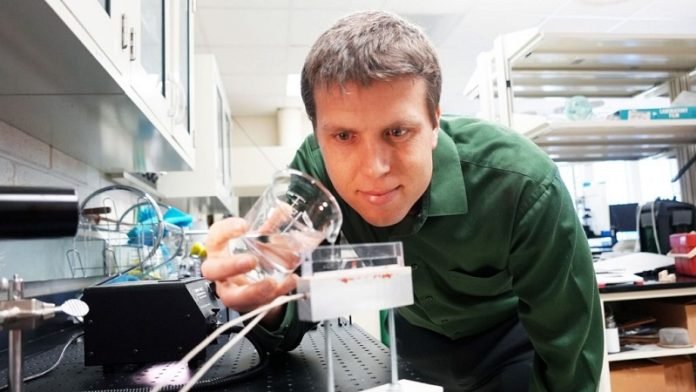
Researchers have come up with a surface that makes water bubbles jump to more efficiently carry heat.
Water is often the go-to resource for heat transfer, being used in large-scale cooling operations like data centers that power the internet and nuclear power plants that power cities.
Discovering dynamic phenomena to make water-based heat transfer more energy and cost efficient is the ongoing work of Jonathan Boreyko, associate professor in mechanical engineering at Virginia Tech.
Boreyko and his team have published extensively on the topic of water and the way it can move, with members of his Nature-Inspired Fluids and Interfaces Lab producing water droplets that leap propelled by surface tension and frost that jumps by way of electrostatics.
Having incorporated the two phases of liquid and solid in the first two volumes, their third volume investigates a third phase with boiling water.
“During my PhD research at Duke University, I discovered jumping water droplets,” Boreyko says. “A decade later, my own graduate student discovered jumping ice during his research on frost growth.
This made me determined to complete a three-phase “trilogy” for jumping water, which we achieved here with this paper on jumping bubbles during the boiling of water.
Graduate student Hyunggon Park created a micro-structured boiler capable of releasing bubbles at one-tenth the usual size, deploying a steady barrage of bubbles to carry energy.
The result is a more efficient method of removing heat from a surface.
“When Hyunggon showed me the first videos of these jumping bubbles that complete the trilogy, needless to say, I was jumping with excitement.”
Boiling is the most efficient way to continuously transfer heat through water. If boiling remains constant, so does the departure of energy. Energy is carried away in bubbles, like spherical cars carrying heat passengers. Those bubbles normally depart when their own buoyancy becomes stronger than surface adhesion, causing them to rise to the surface and release the energy.
Park and Boreyko’s new method improves on that principle by making the fleet of bubble cars smaller and more numerous. Because there is a more constant departure of bubbles, more energy passengers are also leaving.
The bubbles aren’t waiting for their own buoyancy to do the work, but they are leaping away from the heated surface at a faster rate. Because the bubbles are also microscopically small, the team has solved a breakdown that occurs with larger bubbles and stalls heat removal.
“Normally, buoyancy detaches these surface bubbles when they are millimeters in diameter, allowing them to escape and take the heat away as steam,” says Boreyko.
“When boiling at higher temperatures, these large surface bubbles merge together to form a continuous vapor film. This film insulates the liquid from the hot surface, causing a breakdown in heat transfer.”
The secret to the team’s method is found in the engineered surfaces they have created. By fabricating an array of micro-cavities onto the boiling surface, bubbles preferentially form and grow within the cavities.
Pairs of cavities are intentionally placed very close together, causing neighboring bubbles to coalesce together at unusually small sizes.
At such small sizes, the force of surface tension is very strong, causing the bubbles to jump away from the surface as they merge together. In the case of a data center, more rapid removal of heat from a surface could mean the difference between business as usual and costly downtime.
In many ways, this jumping-bubble effect is very similar to the jumping dew droplets Boreyko previously discovered. The use of surface tension proved valuable in both cases, but the added factor of heat brings new dynamics into the picture.
Putting those pieces together, Boreyko expects that the jumping phenomenon will be more practical when finding widespread applications for cooling and heat transfer.
“To cause droplets to jump, the surface needs a hydrophobic coating and ultra-small nanostructures, both of which are fragile and expensive,” Boreyko explains.
“In contrast, bubbles prefer jumping on a hydrophilic surface, which allows for uncoated metals to be used. Also, the micro-cavities required for jumping bubbles are much larger and more durable than the nanostructures needed for jumping droplets.”
This project lays deeper groundwork for understanding the fluid mechanics of the jumping bubble effect. The next step is measuring the improved heat transfer through boiling, mapped over a wide range of temperatures and surface geometries, to gain a better understanding of the full potential of jumping-enhanced boiling.
The study appears in Advanced Functional Materials.



